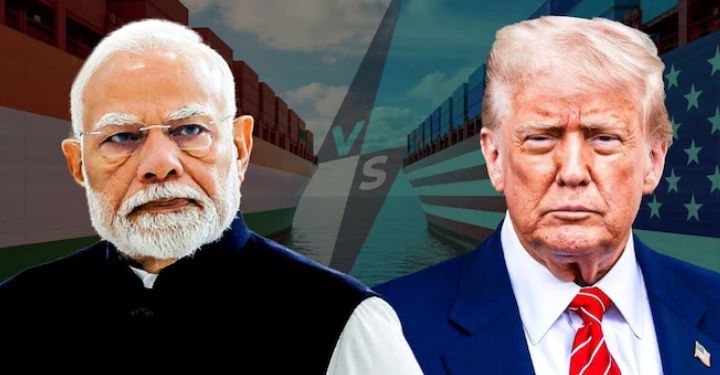The U.S. administration, led by President Donald Trump, has escalated its legal battle over sweeping tariffs by appealing to the Supreme Court in a move that ties trade policy directly to global security. In court documents filed on September 4, Solicitor General John Sauer argued that tariffs on Indian imports are a “crucial aspect” of broader peace-building efforts in Ukraine—and must be upheld quickly.
The appeal follows a 7–4 ruling by the U.S. Court of Appeals for the Federal Circuit, which deemed most of the tariffs illegal under the International Emergency Economic Powers Act (IEEPA), a 1977 statute. That decision was based on the judiciary’s conclusion that IEEPA does not grant the president authority to impose broad import taxes—a power reserved for Congress.
Tying Tariffs to Peace in Ukraine
The crux of the argument rests on the Trump administration’s calculation that tariffs on India serve multiple strategic purposes:
- Penalising India’s Russian oil imports: India was singled out for its continued purchases of Russian energy, seen by Washington as indirectly financing Moscow’s war in Ukraine. To that end, the U.S. imposed a 25% “reciprocal” tariff and an additional 25% levy, bringing the total duty to 50% on Indian goods.
- Promoting economic leverage as peace incentive: According to the Supreme Court appeal, these tariffs are “a crucial aspect” of efforts to restore peace in Ukraine. The administration claimed that “with tariffs, the United States is a rich nation; without tariffs, a poor nation,” arguing that removal of such measures would expose the U.S. to trade retaliation and economic catastrophe.
- Securing trade and framework deals: The administration highlighted that six major trading partners, along with the 27‑nation European Union, have entered into “framework deals” following tariff threats, agreeing to around USD 2 trillion in purchases and investments aligned more closely with U.S. interests.
- Shielding national security: Officials have emphasized that these tariffs simultaneously strengthen economic defenses and bolster the national and defense-industrial base—elements seen as essential to a broader peace strategy.
Legal Battle: Authority vs. Emergency Powers
At issue is whether the president may invoke emergency powers to set tariffs, a legislative prerogative. The appeals court ruled that imposing tariffs—not explicitly authorized in IEEPA—constitutes Congressional territory. The administration now seeks urgent review by the Supreme Court, emphasizing the high stakes and asking justices to act swiftly.
The priorities are clear:
- Prevent diplomatic harm: The administration warns that rolling back the tariffs would undercut current negotiations and could trigger “dangerous diplomatic embarrassment,” potentially unraveling existing and proposed trade frameworks.
- Avoid economic fallout: Officials claim the removal of tariffs could thrust the U.S. “back to the brink of economic catastrophe,” citing threats to the defense-industrial base and uncertainty in foreign negotiations.
- Timeline pressure: The appeals court has kept the tariffs in effect through at least mid‑October, giving the administration a limited window to secure Supreme Court intervention. The administration has signaled urgency, pushing for expedited review.
Broader Diplomatic Fallout
This legal push comes amid heightened U.S.–India tensions. Indian officials have condemned the tariffs as “unjustified and unreasonable” and stressed their sovereign right to manage energy needs—particularly amid volatile global prices.
Observers warn these tariffs risk undermining decades of strategic cooperation between the U.S. and India. Analysts like Fareed Zakaria and diplomat Kenneth Juster have characterized the move as a setback to the bilateral relationship—potentially threatening regional stability and supply chain diversification.
Notably, Senate voices like Lindsey Graham have suggested that targeting Russia’s buyers, such as India, might pressure Putin into negotiations. Nonetheless, critics including economist Jeffrey Sachs warn that the strategy could unify BRICS nations against Western pressure.
U.S. Domestic Response
Domestically, the judiciary ruling dealt a blow to Trump’s trade agenda, prompting heated legal and political debate. Lawmakers from both parties have raised concerns—Democrat-led House committees argue that targeting India damages U.S. interests and undermines U.S.-India ties while doing little to resolve the Ukraine conflict.
Economists warn of inflation and supply chain disruptions. Legal scholars question the constitutionality of awarding unilateral tariff authority to the executive branch absent Congressional action.
Looking Ahead
The Supreme Court’s decision—should it act quickly—will shape the balance of executive power over trade and, by extension, the U.S.’ role in leveraging economic tools for geopolitical outcomes.
- If the Court upholds Trump’s authority under IEEPA, it would reaffirm executive flexibility in using tariffs as foreign policy levers.
- If the Court strikes down the measure, it could roll back significant tariffs, compel refunds, and prompt Congress to revisit trade emergency powers.
Critically, the ruling will also signal Washington’s willingness to link trade enforcement with foreign policy goals in an era marked by global conflict.
In summary, the Trump administration is appealing to the U.S. Supreme Court to uphold 50% tariffs on Indian imports—framed as necessary economic leverage to deter Russian aggression and promote peace in Ukraine. The case raises urgent constitutional questions and carries significant implications for U.S. authority, trade partnerships, and international diplomacy.





More Stories
Equities Surge, Yen Slides: Japan’s Markets React to Takaichi’s Economic Vision
Deadly Dose: Toxic Cough Syrup Blamed for Deaths of Six Children in Madhya Pradesh
Back in the Sky: India and China Restore Direct Flights from October 26